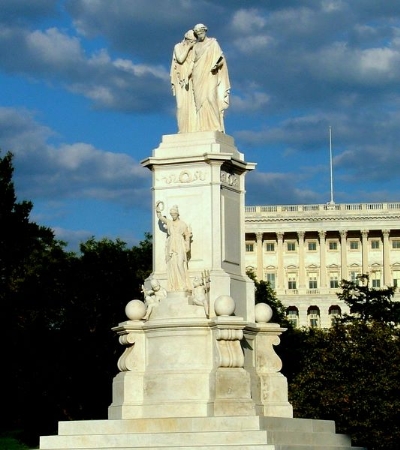In contemplating the profound essence of peace as envisioned in Bahá’í teachings, one might ponder a whimsical query: What if we could materialize a monument that encapsulates the very spirit of harmony and unity in a world fraught with division? As we delve into the intricate tapestry of Bahá’í principles, particularly regarding the design of a steel monument to peace, a multifaceted challenge emerges—how to fuse artistic expression with spiritual significance. The following exposition seeks to elucidate the guiding tenets derived from Bahá’í doctrines, offering a pathway toward the realization of such a monumental edifice.
The Bahá’í Faith places paramount importance on the principles of unity and peace among humanity. At its core, the teachings advocate for a global vision where differences of race, class, and nationality dissolve into a singular identity centered around the oneness of mankind. Consequently, the design of a peace monument must be an embodiment of this principle, symbolizing convergence rather than divergence. Steel, with its robust yet malleable nature, serves as an apt metaphor for resilience and adaptability, qualities essential for fostering global concord.
When embarking upon the conceptual framework of such a monument, an exploration of the symbolisms associated with peace within the Bahá’í tradition is indispensable. For instance, the concept of the “Mansion of Bahá” in which Bahá’u’lláh, the founder of the Bahá’í Faith, lived, serves as a significant motif. It symbolizes a space of loving-kindness and tranquility. In envisioning the steel monument, integrating elements reminiscent of this architectural heritage could imbue the design with historical context and a sense of continuity. Think of abstract representations that mirror the grandeur of the mansion, inviting viewers to reflect on the underlying principles of love and unity.
The dimensions and scale of the monument also warrant meticulous consideration. A towering structure may evoke feelings of awe and majesty, while a more intimate design may foster contemplation and personal connection. Thus, achieving an appropriate scale requires a delicate balance. This raises the challenge of how to inspire individuals at various cognitive and emotional levels. A thoughtfully designed oasis of peace encourages individuals from all walks of life to engage subliminally with the themes of unity and compassion. This leads to a crucial inquiry—how can the monument catalyze genuine dialogue among diverse communities? Implementing interactive elements such as sound installations or digital interfaces could serve as an invitation to share individual narratives of peace, further enriching the collective experience.
Moreover, the materiality of steel can evoke various interpretations depending on its treatment. Smooth, polished surfaces may convey elegance and sophistication, while raw, unfinished textures could symbolize the ongoing struggle for peace—a more dynamic representation of our collective human journey. Such dialectics invite a deeper understanding of the complexities surrounding the pursuit of global harmony. Importantly, reflecting on whether the monument will maintain a presence of vulnerability might challenge preconceptions of strength. Incorporating transparency within the structural design, perhaps through glass elements interwoven with steel, may evoke feelings of openness and accessibility, countering notions of isolationism.
Accessibility serves as another critical dimension in the monument’s design, aligning with Bahá’í teachings that advocate for the inclusion of all members of society. The monument should be a space that invites dialogue, encourages interaction, and engages various stakeholders, including those who may historically have felt marginalized. It poses an exciting challenge: How can the structure be modified to ensure that people of all abilities and backgrounds can experience its significance? This could involve creating pathways that lead to reflective spots or even designing elements that accommodate various sensory experiences, thereby transcending barriers.
To encompass the values of service and humanity, the integration of community engagement in the design and establishment of the monument is paramount. Inviting artists, architects, and local residents to contribute to its creation fosters a collaborative spirit that reflects the very tenets of unity and peace. This participatory approach could blur the lines between artist and observer, creating an enriched narrative that compels individuals to invest in their community. As a result, the process of constructing the monument itself becomes a form of peacebuilding, nourishing relationships and fostering a profound sense of belonging. Taking this a step further, how can the monument serve as a conduit for ongoing civic discourse around issues of conflict resolution and communal harmony?
Lastly, the maintenance and longevity of the monument must be taken into account. As a representation of eternal principles, the edifice should endure the tests of time while continuing to inspire future generations. The challenge then is to employ materials and design strategies that not only withstand environmental factors but also evolve according to the needs of the community it represents. Engaging with sustainable practices aligns harmoniously with Bahá’í teachings, which advocate for the stewardship of the earth and its resources. This, juxtaposed with the monumental idea of forging peace, becomes a profound reflection of how today’s actions shape future realities.
In conclusion, designing a steel monument to peace, grounded in Bahá’í teachings, requires a multifaceted approach that honors the principles of unity, inclusivity, and sustainable development. It beckons a myriad of thoughtful considerations—artistic expression intertwined with spiritual significance, an intimate yet awe-inspiring scale, and an embodiment of collective legacy. Such a monument not only serves as a remarkable architectural feat but also stands resolute as a beacon of both aspiration and invitation in our shared journey toward global harmony.
